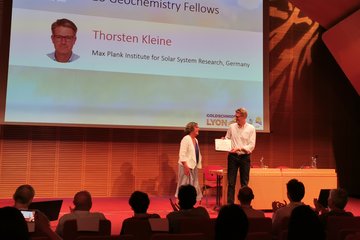Alle Typen
21.
Zeitschriftenartikel
Is near-surface ice the driver of dust activity on 67P/Churyumov-Gerasimenko? Astronomy and Astrophysics 600, A142 (2017)
22.
Zeitschriftenartikel
Estimating the Strength of the Nucleus Material of Comet 67P Churyumov-Gerasimenko. Solar System Research 50, S. 225 - 234 (2016)
23.
Zeitschriftenartikel
3D Direct Simulation Monte Carlo Modelling of the Inner Gas Coma of Comet 67P/Churyumov-Gerasimenko: A Parameter Study. Earth, Moon and Planets 117 (1), S. 41 - 64 (2016)
24.
Zeitschriftenartikel
Acceleration of cometary dust near the nucleus: application to 67P/Churyumov-Gerasimenko. Mon. Not. Roy. Astron. Soc. 461 (4), S. 3410 - 3420 (2016)
25.
Zeitschriftenartikel
A model of short-lived outbursts on the 67P from fractured terrains. Astronomy and Astrophysics 593, A76 (2016)
26.
Zeitschriftenartikel
What drives the dust activity of comet 67P/Churyumov-Gerasimenko? Astronomy and Astrophysics 583, A12 (2015)
27.
Zeitschriftenartikel
Insolation, erosion, and morphology of comet 67P/Churyumov-Gerasimenko. Astronomy and Astrophysics 583, A34 (2015)
28.
Zeitschriftenartikel
The changing rotation period of comet 67P/Churyumov-Gerasimenko controlled by its activity. Astronomy and Astrophysics 579, L5 (2015)
29.
Zeitschriftenartikel
Observations of the long-lasting activity of the distant Comets 29P Schwassmann-Wachmann 1, C/2003 WT42 (LINEAR) and C/2002 VQ94 (LINEAR). Icarus 211 (1), S. 559 - 567 (2011)
30.
Zeitschriftenartikel
Activity of comets: Gas transport in the near-surface porous layers of a cometary nucleus. Icarus 212 (2), S. 867 - 876 (2011)
31.
Zeitschriftenartikel
Optical properties of aerosols in Titan's atmosphere: Large fluffy aggregates. Planetary and Space Science 58 (14-15), S. 1802 - 1810 (2010)
32.
Zeitschriftenartikel
The properties of Titan's surface at the Huygens landing site from DISR observations. Planetary and Space Science 56, S. 728 - 752 (2008)
33.
Zeitschriftenartikel
Optical properties of aerosols in Titan's atmosphere. Planetary and Space Science 56 (5), S. 660 - 668 (2008)
34.
Zeitschriftenartikel
Direct statistical simulation of the near-surface layers of the cometary atmosphere. I. A spherical nucleus. Solar System Research 38 (6), S. 455 - 475 (2004)
35.
Zeitschriftenartikel
On the light-absorbing surface layer of cometary nuclei - II. Thermal modeling. Icarus 159 (1), S. 239 - 258 (2002)
36.
Zeitschriftenartikel
On the light-absorbing surface layer of cometary nuclei I. Radiative transfer. Icarus 156, S. 223 - 248 (2002)
37.
Zeitschriftenartikel
Thermophysical modelling of Comet P/Borrelly: Effects of volume energy absorption and volume sublimation. Earth, Moon and Planets 90, S. 293 - 303 (2002)
38.
Zeitschriftenartikel
A model of heat and mass transfer in a porous cometary nucleus based on a kinetic treatment of mass flow. Icarus 153 (1), S. 180 - 196 (2001)
39.
Zeitschriftenartikel
Stability of water ice under a porous nonvolatile layer: implications to the south polar layered deposits of Mars. Planetary and Space Science 49 (1), S. 59 - 63 (2001)
40.
Zeitschriftenartikel
Mass and Energy Balance in the Near-Surface Layers of a Cometary Nucleus. Icarus 140, S. 173 - 188 (1999)











